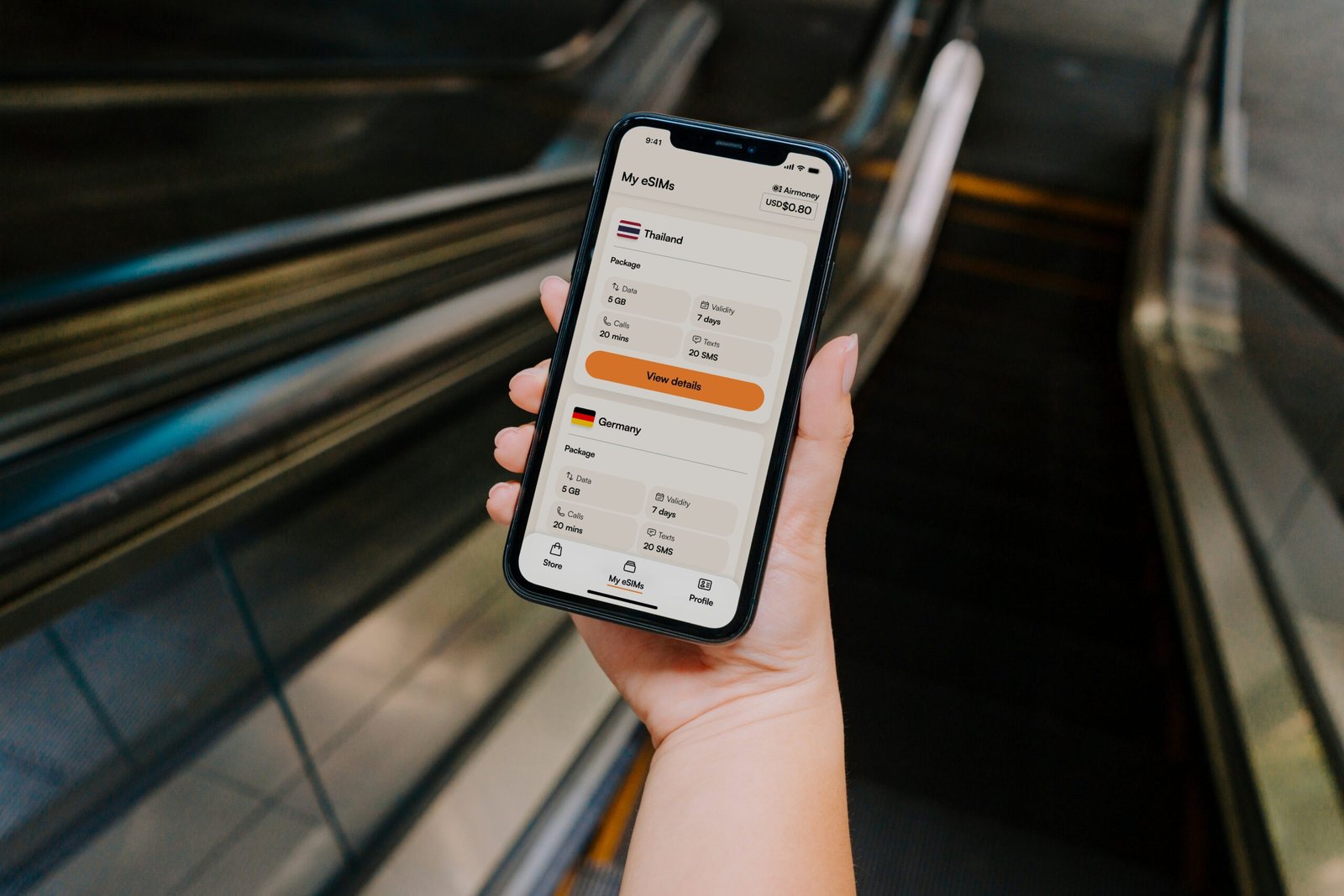
eSIM Technology: The Future of Global Connectivity for Digital Nomads and Business Travelers
connected world, staying online while traveling has become as essential as packing your passport. The evolution of mobile connectivity has reached a revolutionary milestone with the introduction of embedded SIM (eSIM) technology. This digital innovation is transforming how we approach international roaming, offering unprecedented flexibility and convenience for modern travelers, digital nomads, and business professionals who refuse to compromise on connectivity.
The traditional challenges of international travel connectivity are well-known: exorbitant roaming charges, the hassle of finding local SIM cards, language barriers at mobile stores, and the constant worry about losing tiny physical SIM cards. These pain points have created a significant demand for more efficient solutions, and eSIM technology has emerged as the definitive answer. For travelers heading to popular destinations, solutions like eSIM Turkey have made staying connected seamless and affordable.
Understanding eSIM Technology: Beyond Traditional SIM Cards
eSIM represents a fundamental shift in mobile connectivity architecture. Unlike traditional physical SIM cards that require manual insertion and removal, eSIM is a programmable chip embedded directly into your device’s motherboard. This embedded solution eliminates the physical constraints of conventional SIM cards while offering enhanced security, reliability, and flexibility.
The technology operates on the same cellular principles as traditional SIM cards but leverages remote provisioning capabilities. Users can download and activate multiple carrier profiles directly to their device without visiting a store or waiting for physical delivery. This digital-first approach has revolutionized international connectivity, making it possible to switch between carriers and plans instantly through simple software updates.
Modern smartphones, tablets, smartwatches, and even some laptops now come equipped with eSIM capabilities. Major manufacturers including Apple, Samsung, Google, and others have integrated this technology into their flagship devices, recognizing its potential to simplify global connectivity. The adoption rate has been accelerating rapidly, with industry analysts predicting that eSIM will become the dominant SIM technology within the next decade.
The Digital Nomad Revolution and Connectivity Demands
The rise of remote work and digital nomadism has created a new category of travelers with unique connectivity requirements. Unlike traditional tourists who might prioritize cost savings over consistent connectivity, digital nomads need reliable, high-speed internet access to maintain their professional obligations while exploring the world. This demographic shift has driven innovation in mobile connectivity solutions, with eSIM technology emerging as the preferred choice for location-independent professionals.
Digital nomads often work across multiple time zones, participate in video conferences, upload large files, and maintain constant communication with clients and team members. Traditional roaming solutions often fail to meet these demands due to speed limitations, data caps, or prohibitive costs. Business travelers heading to major markets frequently choose eSIM USA plans to ensure seamless connectivity for critical business operations without the complexity of traditional roaming arrangements.
The flexibility offered by eSIM technology aligns perfectly with the unpredictable nature of nomadic lifestyles. Travelers can research and purchase connectivity solutions before departure, activate services upon arrival, and switch between carriers as needed based on coverage quality and pricing. This level of control and convenience was previously impossible with traditional SIM card solutions.
Cost-Effectiveness and Budget Optimization for Travelers
One of the most compelling advantages of eSIM technology is its potential for significant cost savings compared to traditional international roaming. Traditional carrier roaming charges can be astronomical, often ranging from $10-$15 per day for basic data packages, with additional charges for voice calls and text messages. These costs can quickly accumulate during extended travel periods, making traditional roaming financially unsustainable for budget-conscious travelers.
eSIM providers typically offer more competitive pricing structures designed specifically for international usage. Many providers offer flexible packages ranging from short-term daily plans to extended monthly or even yearly options. This pricing flexibility allows travelers to optimize their connectivity costs based on their specific usage patterns and travel duration.
The elimination of physical SIM card logistics also reduces operational costs for providers, savings that are often passed on to consumers. Additionally, the ability to purchase and activate services digitally eliminates the markup typically associated with physical retail distribution channels. Travelers can compare prices across multiple providers instantly and make informed decisions based on their budget and connectivity requirements.
Security Advantages and Protection Against SIM-Related Threats
Security represents a critical advantage of eSIM technology over traditional physical SIM cards. Physical SIM cards are vulnerable to theft, loss, and sophisticated attacks such as SIM swapping, where criminals convince carriers to transfer a victim’s phone number to a new SIM card under their control. This type of attack has become increasingly common and can lead to identity theft, financial fraud, and unauthorized access to sensitive accounts.
eSIM technology addresses these vulnerabilities through enhanced digital security measures. The embedded nature of eSIM makes it virtually impossible to physically remove or steal. Additionally, many eSIM implementations include advanced encryption and authentication protocols that provide superior protection against unauthorized access attempts.
The remote provisioning capabilities of eSIM also enable more sophisticated security features, including the ability to remotely disable or modify SIM profiles in case of device theft. This capability provides travelers with additional peace of mind, knowing that their connectivity can be secured even if their device falls into the wrong hands.
Regional Connectivity Solutions and Market-Specific Advantages
Different regions present unique connectivity challenges and opportunities, making regional eSIM solutions particularly valuable for targeted travel. Each market has distinct carrier landscapes, regulatory environments, and infrastructure characteristics that influence connectivity quality and pricing.
For travelers visiting emerging markets with rapidly developing mobile infrastructure, eSIM solutions provide access to the latest network technologies without the complexity of navigating local carrier stores and language barriers. Markets like China present particular challenges for international travelers due to regulatory restrictions and the Great Firewall, making specialized solutions like eSIM China essential for maintaining unrestricted internet access.
Regional eSIM providers often establish partnerships with multiple local carriers, providing travelers with access to the best available coverage and speeds in each location. This multi-carrier approach ensures redundancy and optimizes connectivity quality across different geographic areas within a region.
Device Compatibility and Technical Requirements
The widespread adoption of eSIM technology has been facilitated by increasing device compatibility across major manufacturers and device categories. Most flagship smartphones released after 2018 include eSIM capabilities, with manufacturers continuing to expand support across mid-range and budget device categories.
However, device compatibility varies by manufacturer, model, and even regional variants of the same device. Travelers should verify eSIM compatibility before purchasing plans, as some carriers may restrict eSIM activation to specific device models or software versions. Many devices support dual SIM functionality, allowing users to maintain their primary SIM while adding eSIM connectivity for travel purposes.
The activation process typically involves scanning a QR code or entering activation details provided by the eSIM provider. This process is generally straightforward but may require internet connectivity for initial setup. Some providers offer alternative activation methods for users without immediate internet access, including phone-based activation services.
Environmental Impact and Sustainability Considerations
The environmental implications of eSIM technology extend beyond individual convenience to broader sustainability benefits. Traditional SIM card production requires plastic manufacturing, packaging materials, and global distribution networks that contribute to environmental waste and carbon emissions. The physical retail infrastructure required for SIM card distribution also represents a significant environmental footprint.
eSIM technology eliminates these environmental impacts through its entirely digital delivery model. The reduction in plastic waste alone is substantial when considered across the billions of SIM cards produced annually. Additionally, the elimination of physical distribution networks reduces transportation-related carbon emissions and the environmental impact of retail locations.
For environmentally conscious travelers, choosing eSIM solutions represents a meaningful way to reduce their travel-related environmental impact while maintaining necessary connectivity. This alignment with sustainability values has become increasingly important for younger travelers and corporate travel programs with environmental responsibility mandates.
Future Developments and Industry Trends
The eSIM industry continues to evolve rapidly, with several emerging trends pointing toward even greater convenience and functionality. Industry development focuses on expanding carrier partnerships, improving activation processes, and integrating eSIM capabilities into a broader range of connected devices.
One significant trend involves the integration of artificial intelligence and machine learning to optimize network selection and data usage patterns automatically. Future eSIM solutions may automatically switch between carriers based on coverage quality, speed, and cost optimization without user intervention.
The Internet of Things (IoT) represents another major growth area for eSIM technology. As connected devices become more prevalent in travel contexts, from smart luggage to portable hotspots, eSIM technology will enable seamless connectivity for entire ecosystems of travel-related devices.
Industry consolidation and standardization efforts are also shaping the future landscape, with major technology companies and carriers working to establish common standards that will further improve interoperability and user experience across different devices and networks.
Frequently Asked Questions
What devices support eSIM technology?
Most modern smartphones including iPhone XS and newer, Google Pixel 3 and newer, Samsung Galaxy S20 and newer series support eSIM. Many tablets, smartwatches, and some laptops also offer eSIM capabilities. Always check your specific device model’s compatibility before purchasing eSIM plans.
Can I use eSIM alongside my regular SIM card?
Yes, most eSIM-capable devices support dual SIM functionality, allowing you to maintain your primary physical SIM while adding eSIM connectivity for travel or additional services. You can typically switch between lines or use both simultaneously for different purposes.
How do I activate an eSIM plan?
Activation typically involves scanning a QR code provided by your eSIM provider or manually entering activation details in your device’s cellular settings. The process usually requires internet connectivity for initial setup and takes just a few minutes to complete.
Is eSIM more expensive than traditional roaming?
eSIM plans are generally more cost-effective than traditional carrier roaming charges. While pricing varies by provider and destination, eSIM solutions typically offer better value, especially for extended travel periods or high data usage requirements.
What happens if I lose my device with an eSIM?
Unlike physical SIM cards, eSIM profiles can be remotely managed and deactivated for security purposes. Many providers offer customer service options to suspend or transfer your eSIM service to a new device, providing better security than traditional SIM cards.
Can I switch between eSIM providers easily?
Yes, you can typically download and activate multiple eSIM profiles on compatible devices and switch between them as needed. This flexibility allows you to optimize connectivity based on location, pricing, or service quality without physical SIM card changes.
The future of global connectivity clearly belongs to eSIM technology. As digital infrastructure continues to evolve and travel patterns become increasingly complex, the flexibility, security, and cost-effectiveness of eSIM solutions make them indispensable tools for modern travelers. Whether you’re a digital nomad working from remote locations, a business professional managing international operations, or a leisure traveler seeking hassle-free connectivity, eSIM technology provides the foundation for seamless global communication that adapts to your unique needs and travel patterns.



